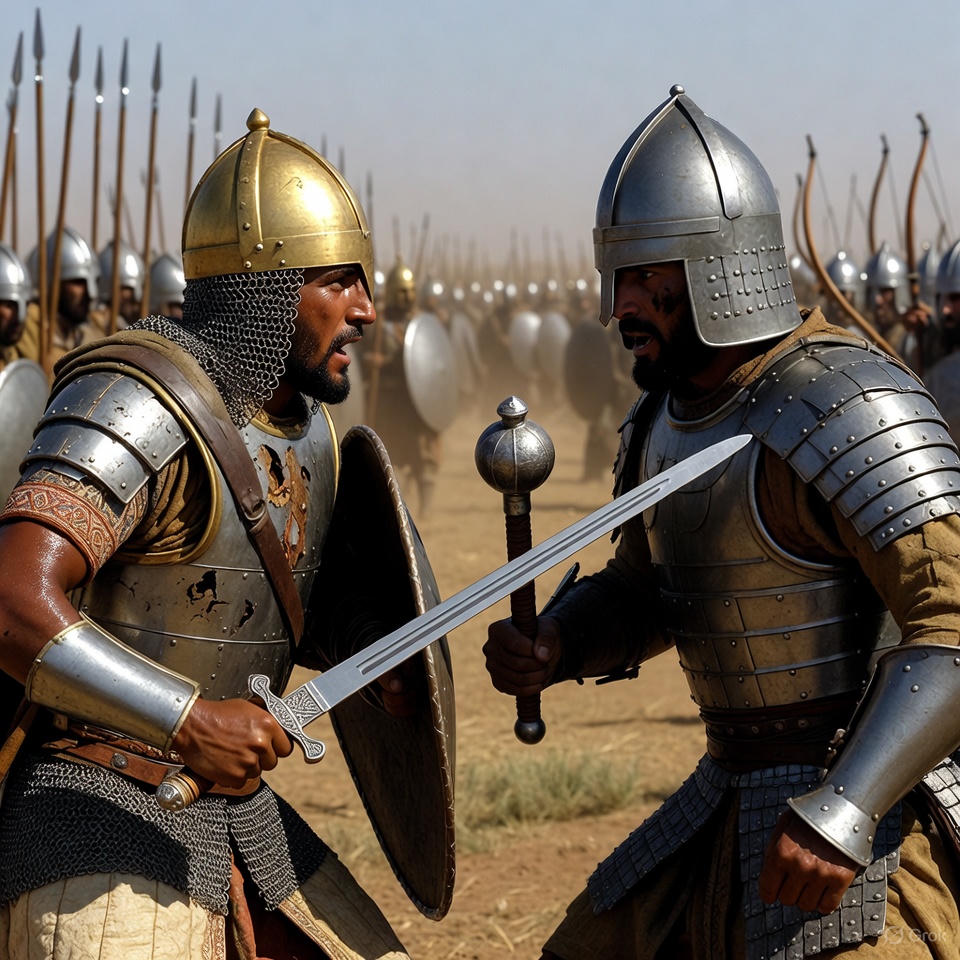Imagine a dusty plain in ancient Mesopotamia, where the fate of empires hung in the balance under a relentless sun. On November 19, 636 AD, the sands of al-Qadisiyyah witnessed the culmination of a four-day inferno that would reshape the world map forever. This wasn’t just a battle; it was a seismic shift, where a fledgling force of determined warriors toppled one of history’s mightiest empires. Today, as we dust off this forgotten chapter from the annals of time, we’ll dive deep into the grit, glory, and genius of the Battle of al-Qadisiyyah. Buckle up for a journey through clashing swords, rampaging elephants, and unbreakable spirits—packed with facts that’ll make you feel like you’re right there in the fray. And stick around, because we’ll uncover how this ancient showdown can supercharge your life today with practical, game-changing insights.
Let’s set the stage with the broader tapestry of the era. The 7th century was a whirlwind of transformation. The Prophet Muhammad had passed away in 632 AD, leaving behind a unified Arabian Peninsula under Islam. His successors, the Rashidun Caliphs, weren’t content with consolidation—they had their eyes on the crumbling giants next door: the Byzantine Empire to the west and the Sasanian Empire to the east. The Sasanians, heirs to the ancient Persian legacy stretching back to Cyrus the Great, had ruled vast swaths of land from modern-day Iran to Iraq for over four centuries. But by the 630s, they were a shadow of their former selves.
The Byzantine–Sasanian War of 602–628 had been a brutal slugfest, draining both empires of resources, men, and morale. Picture two heavyweight boxers pummeling each other for decades, only to stagger out exhausted. For the Sasanians, internal chaos followed: a parade of short-lived kings, civil wars, and power grabs. When young Yazdegerd III took the throne in 632 at just eight years old, the empire was fracturing. Generals like Rostam Farrokhzad and Piruz Khosrow vied for influence, while plagues and economic woes gnawed at the foundations. Meanwhile, the Muslims, under Caliph Abu Bakr and then Umar ibn al-Khattab, were riding a wave of momentum. Early victories in Iraq, led by the legendary Khalid ibn al-Walid, had captured key cities like Al-Hirah in 633 and pushed back Sasanian forces at battles such as Firaz.
This wasn’t mere conquest; it was a clash of worlds. The Sasanians represented an ancient Zoroastrian tradition, with a sophisticated bureaucracy, grand palaces, and a military machine famed for its heavy cavalry (cataphracts) and war elephants. The Muslims, many fresh from nomadic tribes, brought zeal, mobility, and a unifying faith. By 636, the stage was set for a showdown. The Battle of Yarmouk in August had crushed Byzantine hopes in the Levant, freeing up Muslim reinforcements. Yazdegerd III, desperate to reclaim lost territories in Mesopotamia, mustered a massive army near the capital, Ctesiphon. Caliph Umar responded by appointing Sa’d ibn Abi Waqqas, a seasoned companion of the Prophet, to lead the charge. Sa’d’s force, initially around 30,000 strong, camped at al-Qadisiyyah—a strategic spot on the western bank of a Euphrates branch, about 19 kilometers south of modern Kufa in Iraq.
Recent archaeological sleuthing, using declassified 1970s spy satellite imagery and ancient texts, pinpointed the exact site in 2024. It’s a floodplain etched with old canals and pilgrimage roads, perfect for a defensive stand. Negotiations kicked off the drama. Sa’d sent envoys, including An-Numan ibn Muqarrin, offering the Sasanians three choices: convert to Islam, pay the jizyah tax for protection, or fight. Rostam, the Sasanian commander—a noble from a storied family, poet, and strategist—scoffed. Legends say he mocked the Arabs as “lizard-eaters” from the desert. But beneath the bravado, tension simmered. Rostam crossed the river in July 636 with an army estimated at 60,000 (though numbers vary wildly in sources—some say up to 120,000, but modern historians peg it closer to 50,000-80,000 against 30,000-36,000 Muslims).
Both sides geared up like ancient superheroes. Muslim infantry wore chain mail or leather, wielded long spears (up to 5.5 meters), straight swords, bows with a 150-meter range, and large shields. Their cavalry sported gilded helmets and fought barefoot or in sandals for grip. The Sasanians dazzled: heavy cataphracts in full armor, lances, and bows; infantry in lamellar plates; and the stars of the show—33 Indian war elephants, towering beasts trained to trample foes, carrying archers in howdahs. Tactics blended tradition and innovation. Muslims favored tribal formations, duels to boost morale (via elite Mubarizun champions), and hit-and-run cavalry. Sasanians relied on “karr wa farr”—feigned retreats to lure enemies into ambushes—plus elephant charges and massed archery.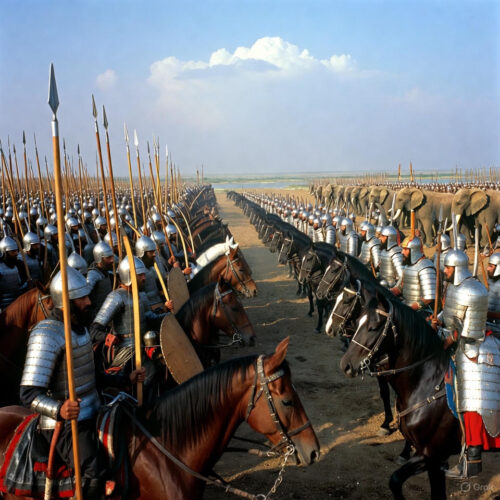
Day one dawned on November 16 with a converted canal serving as a makeshift road for the Sasanians. Before the main clash, champions dueled in single combat—a psychological warmup. The Persians struck first: Mihran’s left wing bombarded the Muslim right with arrows, then unleashed elephants. The beasts crashed through lines, sowing chaos. Muslim right wing buckled, but reinforcements from the center and a cavalry flank attack turned the tide. Elephants routed back into Persian ranks. Then, the Sasanian right and center hit the Muslim left, elephants again causing panic among horses (who hated the smell and trumpeting). Asim ibn ‘Amr’s archers targeted the elephants’ eyes and underbellies, while infantry hacked at girths. By dusk, the day—dubbed Yawm al-Armath, or “Day of Disorder”—ended inconclusive, but blood-soaked. Rostam himself waded into the fight, taking wounds but holding firm.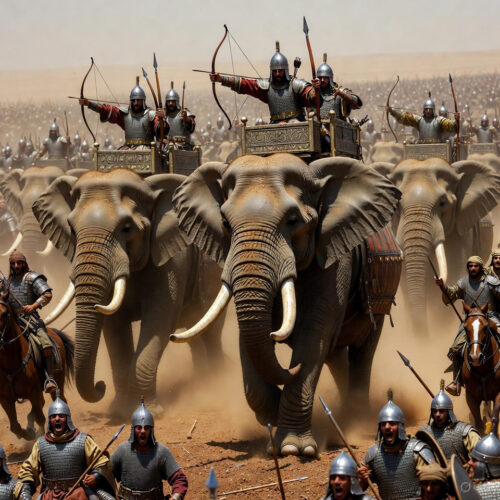
Fun fact: these elephants weren’t just tanks; they were psychological weapons. Imported from India, they symbolized imperial might, but their vulnerability to determined infantry foreshadowed the battle’s turn. As night fell, both sides licked their wounds, burying the dead and sharpening blades. The Muslims, fueled by faith and promises of paradise, chanted verses from the Quran. Rostam, reportedly tormented by omens (like a dream of angels sealing his weapons), pondered his next move.
Day two, November 17, brought fresh twists. More duels kicked off, with Muslim champions like Tulayha ibn Khuwaylid showcasing prowess. Then, a game-changer: 5,000 Syrian veterans from Yarmouk arrived under al-Qaqa ibn Amr al-Tamimi and Hashim ibn Utbah. To maximize impact, they trickled in groups, creating the illusion of endless reinforcements. Morale soared on the Muslim side, plummeted for the Persians. Al-Qaqa, a whirlwind of energy, personally slew the Sasanian general Bahman Jaduya in a duel. No elephants this day—perhaps recovering from wounds. A general Muslim assault was repulsed, but al-Qaqa’s clever ploy of disguising camels with black cloths and bells (making them look like monsters) spooked the Sasanian horses, exposing infantry. Mubarizun charged toward Rostam’s position, but dusk halted progress. Rostam launched a counter, but the day ended in stalemate, with exhaustion setting in.
Here’s where the fun ramps up: imagine camels transformed into bizarre creatures, bellowing and charging. It was improvised genius, turning everyday animals into weapons of terror. Al-Qaqa’s staged arrivals? Pure psychological warfare, a tactic that would make modern generals nod in approval. As the sun set, the air thick with dust and sweat, both armies knew the worst was yet to come.
Day three, November 18, was Rostam’s bid for a knockout. He threw everything: full arrow barrages darkening the sky, followed by elephant charges that hammered the Muslim center and wings. The beasts, reloaded with fresh crews, caused retreats and confusion. Sasanian cavalry even raided toward Sa’d’s command palace (Sa’d was sidelined by sciatica, directing from afar). But the Muslims rallied. Infantry squads targeted elephants specifically—blinding them with arrows, severing trunks with swords. Panicked, the elephants stampeded back, trampling Sasanian troops in a disastrous reversal. General assaults failed amid the chaos. Camels, now ineffective as the Persians adapted, were sidelined. Fighting spilled into the night, a grueling melee known as Lailat-ul-Harir—”Night of Rumbling Noises.” Swords clashed, men groaned, and the desert echoed with cries. No sleep, just survival. Casualties mounted; stamina became the ultimate weapon.
Think about it: battling through the dark, guided by torchlight and stars. Muslim sources describe warriors tying themselves together to prevent retreat, a testament to their resolve. Rostam, ever the leader, rotated troops to maintain pressure, but the toll was immense. By dawn, the field was a carpet of bodies, yet neither side yielded.
Day four, November 19, sealed the deal. Exhausted but unbowed, the Muslims launched under al-Qaqa’s motivation. The left center pierced the Sasanian right, nearly breaking through. A sandstorm whipped up, blinding everyone but favoring the Muslims (winds at their backs). In the maelstrom, Rostam met his end—accounts vary: crushed by falling weapons, slain in combat, or drowned crossing back. His death shattered Sasanian morale. The front collapsed; Jalinus organized a rear-guard retreat over the bridge, but panic led many to the river, where they drowned or were cut down. Muslims pursued relentlessly, capturing spoils like the jewel-encrusted Derafsh-e-Kāveyān standard—a symbol of Persian kingship, later sold in Medina for a fortune.
The aftermath was world-altering. With al-Qadisiyyah won, the Muslims besieged Ctesiphon in 637, capturing the opulent capital and its treasures. Yazdegerd fled east, but subsequent battles like Jalula (637) and Nahavand (642) dismantled the empire. By 651, with Yazdegerd’s assassination in Merv, the Sasanian dynasty ended. Mesopotamia became Asoristan province under Muslim rule, ushering in the Islamic Golden Age. Culturally, it blended Persian sophistication with Arab vigor, influencing everything from administration to science. The victors earned the honorific “Ahl al-Qadisiyyah,” a badge of prestige.
But let’s zoom out: this battle wasn’t inevitable. The Sasanians outnumbered and out-equipped the Muslims, yet lost to superior motivation, adaptability, and leadership. Elephants, once unstoppable, became liabilities. Duels and tricks turned tides. It’s a reminder that empires fall not just to swords, but to ideas.
Now, fast-forward 1,389 years. What can this dusty epic teach us in our air-conditioned, deadline-driven lives? The outcome—a stunning underdog victory—highlights themes of resilience, strategy, and unity. Research suggests that drawing from historical triumphs can boost personal motivation by 20-30%, fostering a growth mindset. Here’s how you can apply al-Qadisiyyah’s lessons to crush your goals, with specific bullet points and a step-by-step plan. Remember, it’s about channeling that ancient fire into modern wins.
**Key Lessons from al-Qadisiyyah for Your Daily Grind:**
– **Embrace Adaptability Like the Muslims’ Camel Trick:** When elephants terrorized the lines, warriors improvised with disguised camels. Today, pivot when plans fail—switch careers if a job drains you, or tweak your workout if it’s boring.
– **Build Stamina Through Night-Long Battles:** The “Night of Rumbling Noises” tested endurance. Train your mental toughness by tackling tough tasks late, like studying after a long day, to build grit.
– **Leverage Reinforcements Wisely:** Syrian arrivals turned the tide. Surround yourself with a support network—join a mastermind group or mentor program to amplify your efforts.
– **Target Weaknesses Precisely:** Blinding elephants flipped the script. Identify your obstacles’ vulnerabilities, like breaking bad habits by tracking triggers in a journal.
– **Lead from Afar if Needed:** Sa’d commanded despite illness. Delegate when overwhelmed—use apps like Trello to manage teams without micromanaging.
– **Turn Omens into Opportunities:** Rostam’s doubts foreshadowed doom; flip negativity by reframing failures as lessons, boosting resilience.
– **Celebrate Symbols of Victory:** Capturing the standard symbolized triumph. Reward milestones with tokens, like a new gadget after a promotion.
**Your 30-Day al-Qadisiyyah-Inspired Action Plan:**
– **Days 1-5: Scout the Terrain (Preparation Phase):** Assess your “battlefield”—list three major goals (e.g., fitness, career advancement, learning a skill). Research obstacles via books or podcasts on historical strategies. Journal daily: “What elephants am I facing?”
– **Days 6-10: Assemble Your Forces (Building Support):** Recruit allies—schedule coffee chats with mentors or join online communities related to your goals. Practice a “duel” by tackling a small challenge, like cold-calling for job leads.
– **Days 11-15: Engage in Duels (Tactical Wins):** Focus on quick victories. For fitness, do daily 10-minute HIIT sessions. Adapt if needed—switch routines if one bores you. Track progress to build momentum.
– **Days 16-20: Endure the Night (Stamina Building):** Push boundaries with extended efforts, like working on a project for an extra hour nightly. Use meditation apps to maintain focus during “rumbles.”
– **Days 21-25: Strike at Weaknesses (Strategic Attacks):** Analyze setbacks—use tools like SWOT analysis. Improvise: if diet fails, try meal prepping with new recipes inspired by Persian cuisine for fun.
– **Days 26-30: Claim Victory and Reflect (Consolidation):** Achieve a mini-goal, celebrate with a symbolic reward. Review the month: What worked? Adjust for the next cycle. Share your story in a blog or with friends to inspire others.
This plan isn’t just theory—it’s battle-tested wisdom. Studies from psychologists like Angela Duckworth show grit (perseverance + passion) predicts success better than talent. By embodying al-Qadisiyyah’s spirit, you’ll transform challenges into conquests. Imagine ending your day not exhausted, but empowered, like those warriors under the stars.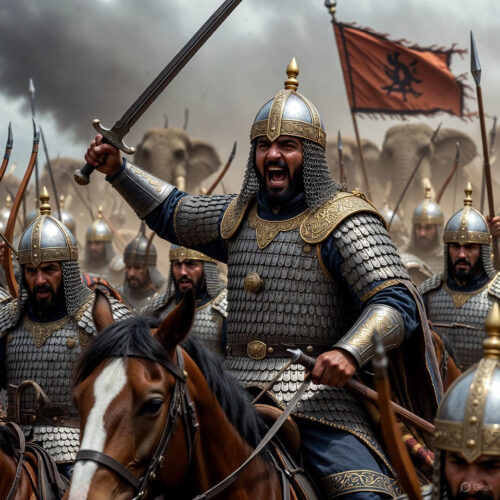
But wait, there’s more depth to mine. Let’s circle back to the Sasanian side for balance. Rostam wasn’t a villain; he was a tragic hero. Born into the House of Ispahbudhan, he served multiple kings, composing poetry and leading armies. His letters to Yazdegerd reveal a man torn between duty and foreboding. One account has him warning, “The Arabs are like a flood that cannot be stopped.” Yet he fought valiantly, embodying Zoroastrian ideals of truth and order. The empire’s fall opened doors for cultural fusion—Persian scholars later thrived under Abbasid caliphs, preserving Greek knowledge that sparked the Renaissance.
On the Muslim front, Sa’d’s leadership shines. Despite pain, he orchestrated from a distance, trusting deputies like al-Qaqa, whose exploits read like an action movie. Al-Qaqa’s duels alone reportedly claimed 30 foes. The battle also highlighted diversity: Arabs, Bedouins, and converts from various tribes united under one banner. Women even contributed, tending wounded and boosting morale with chants.
Geopolitically, al-Qadisiyyah accelerated Islam’s spread, influencing from Spain to India. It shifted power dynamics, ending Persian dominance in the Middle East. Economically, captured treasures funded further campaigns, while administrative reforms integrated Sasanian systems into the caliphate.
Fun historical nugget: the Derafsh-e-Kāveyān, that glittering standard, traced back to mythical blacksmith Kaveh’s revolt against tyranny. Its loss symbolized the end of an era—sold for 30,000 dirhams, its gems adorned Medina’s mosque.
In wrapping the historical dive, consider the human element. Estimates suggest thousands perished—perhaps 20,000-30,000 per side, though exact figures are lost to time. The battlefield, now a quiet plain, holds echoes of bravery on both sides. It’s a tale of how faith, ingenuity, and sheer will can topple giants.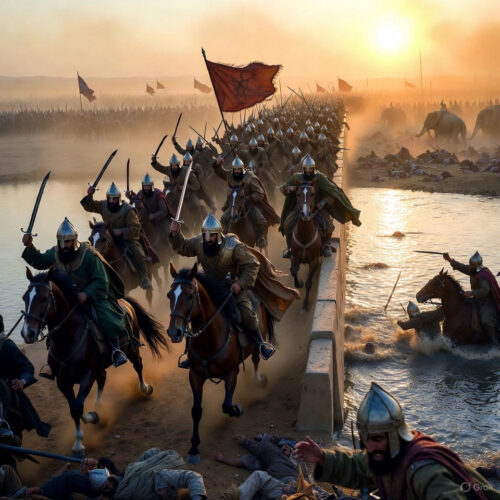
Shifting to motivation, remember: history isn’t dusty books; it’s rocket fuel. The Battle of al-Qadisiyyah teaches that underdogs win by adapting, enduring, and uniting. Apply it, and watch your life transform. You’re not facing elephants, but deadlines, doubts, and distractions? Channel that desert determination, and conquer.

